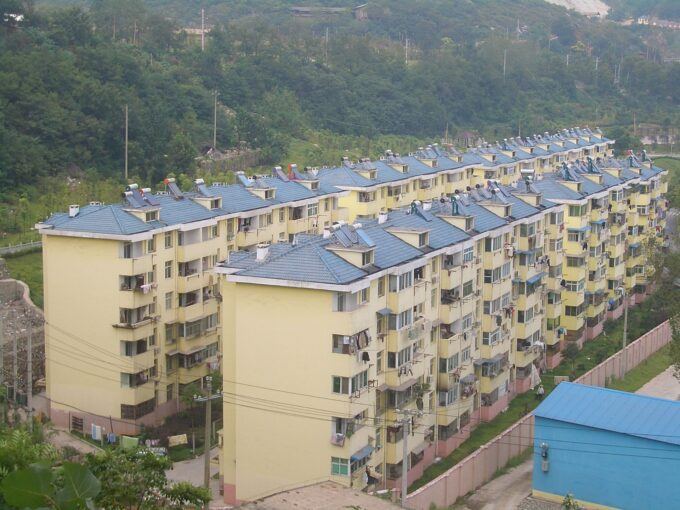






























































Rooftop solar water heaters are ubiquitous in China. Photograph Source: Vmenkov – CC BY-SA 3.0
This summer, China’s commitment to high-level opening-up is in full swing, highlighted by the grand opening of the Third China International Supply Chain Expo (CISCE) in Beijing. This year’s CISCE isn’t just another trade fair; it’s a testament to China’s evolving role in the global economy, showcasing a significant leap in both innovation and green development.
The statistics speak volumes about the Expo’s growing influence and its alignment with global trends. A total of 651 enterprises and institutions from both China and abroad are participating, with the proportion of overseas exhibitors rising to 35 percent. Notably, European and American exhibitors account for 50 percent of all international participants, a clear signal of strong interest from mature markets despite prevailing geopolitical complexities.
Innovation takes center stage at this year’s CISCE. The Expo features over 100 “first-time” launches, exhibitions, and debuts, marking a 10 percent increase from the previous session. The event also includes an “Innovation Chain Zone” for the first time, specifically designed to bridge the gap between groundbreaking laboratory ideas and their industrial application. This initiative aims to transform scientific “golden ideas” into “golden keys” for industrial development, fostering a direct pathway from research to market.
Beyond technological advancements, the Third CISCE underscores a strong commitment to environmental sustainability. For the first time, the entire exhibition hall is powered by green electricity, projected to reduce carbon dioxide emissions by over 1,100 tons. This move is not merely symbolic; it reflects China’s broader dedication to green development and its recognition of sustainability as a crucial component of modern supply chains. It sends a clear message that efficiency and environmental responsibility can, and should, go hand in hand.
The CISCE serves as a vital platform for enterprises worldwide to strengthen resource-sharing and technology collaboration. It’s more than an expo; it’s a new calling card for China’s high-level opening-up. In an era marked by rising unilateralism and protectionism, maintaining the stability and smooth operation of global industrial and supply chains is paramount.
Recent data from China offer a compelling counter-narrative to the prevailing rhetoric of “decoupling” and “passive disruption.” In the first half of this year, China’s total foreign trade in goods exceeded $2.9 trillion, reaching a historic high for the same period. This robust performance has effectively countered the tendencies of forced disengagement and active decoupling, demonstrating the inherent resilience and interconnectedness of global production and supply networks.
This resilience isn’t accidental. It’s the result of concerted efforts to foster an open and collaborative environment. The active participation of a diverse range of international exhibitors at CISCE, particularly from Europe and America, further reinforces the idea that global businesses recognize the indispensable role China plays in their supply chain strategies. They’re here not just to showcase products but to forge partnerships, explore new technologies, and secure their positions within a deeply integrated global economy.
Such direct engagement at CISCE provides a crucial channel for dialogue and trust-building that often gets lost in high-level geopolitical discourse. It allows companies to assess opportunities firsthand, understand regulatory shifts, and build the personal connections vital for complex cross-border operations. This bottom-up collaboration, driven by genuine business needs and a shared pursuit of efficiency, stands as a powerful counterweight to top-down pressures for fragmentation. It underscores a practical reality: interdependence in global manufacturing and trade is simply too deeply woven to be easily unraveled.
This approach stands in contrast to recent U.S. strategies, which have often prioritized “reshoring,” “friendshoring,” and “de-risking” to reduce reliance on specific countries, particularly China. Although the United States aims to bolster national security and supply chain resilience by bringing production closer to home or to allied nations, China’s CISCE champions a vision of interconnectedness and shared prosperity. The American strategy tends to emphasize security through diversification and localized control, often involving significant government incentives for domestic production. In contrast, China, through initiatives like the CISCE, focuses on reinforcing the openness and stability of existing global networks, inviting international partners to continue leveraging its vast manufacturing capabilities and market opportunities. This divergence highlights two distinct philosophies: one prioritizing strategic autonomy, the other advocating for deeper global integration as the ultimate form of resilience.
Looking ahead, the deep integration of global industrial and supply chains and the symbiotic, win-win coexistence of enterprises worldwide appear unstoppable. Despite geopolitical headwinds and calls for reshoring or nearshoring, the economic logic of global collaboration remains compelling. The efficiency, innovation, and cost-effectiveness derived from complex, interconnected supply chains are difficult to replicate purely within national borders. Indeed, the sheer scale and sophistication of China’s manufacturing base, coupled with its immense consumer market, make it an irreplaceable node in many global value chains. Attempts to entirely disengage often lead to higher costs, reduced innovation, and a loss of competitive edge for businesses.
China, for its part, remains steadfast in its commitment to working with all parties to safeguard the stability and smooth operation of global industrial and supply chains. This commitment extends beyond trade figures; it encompasses fostering an open world economic system where shared prosperity is the ultimate goal. The CISCE exemplifies this vision by creating a space for dialogue, innovation, and partnership, thereby strengthening the very fabric of global commerce and giving it a Green twist.
This first appeared on FPIF.
The post Beyond Decoupling: China’s Expo Charts a Sustainable Future appeared first on CounterPunch.org.
This post was originally published on CounterPunch.org.